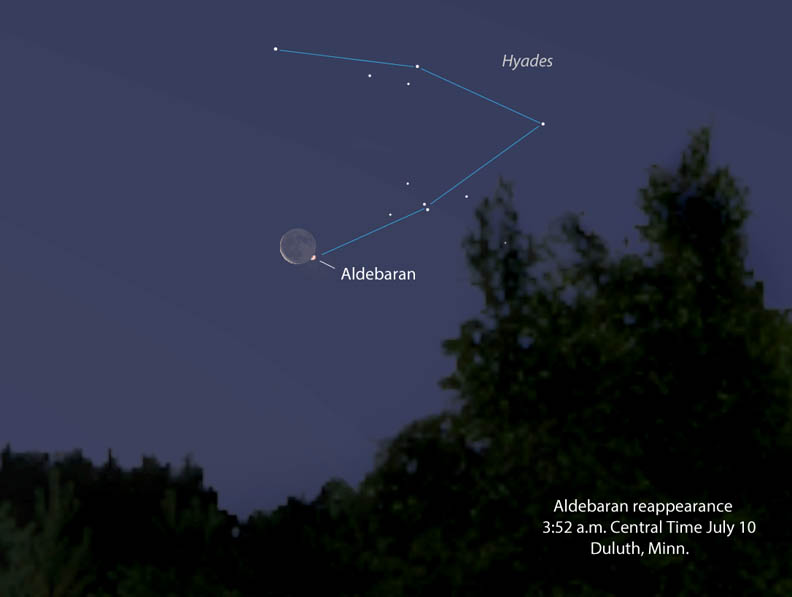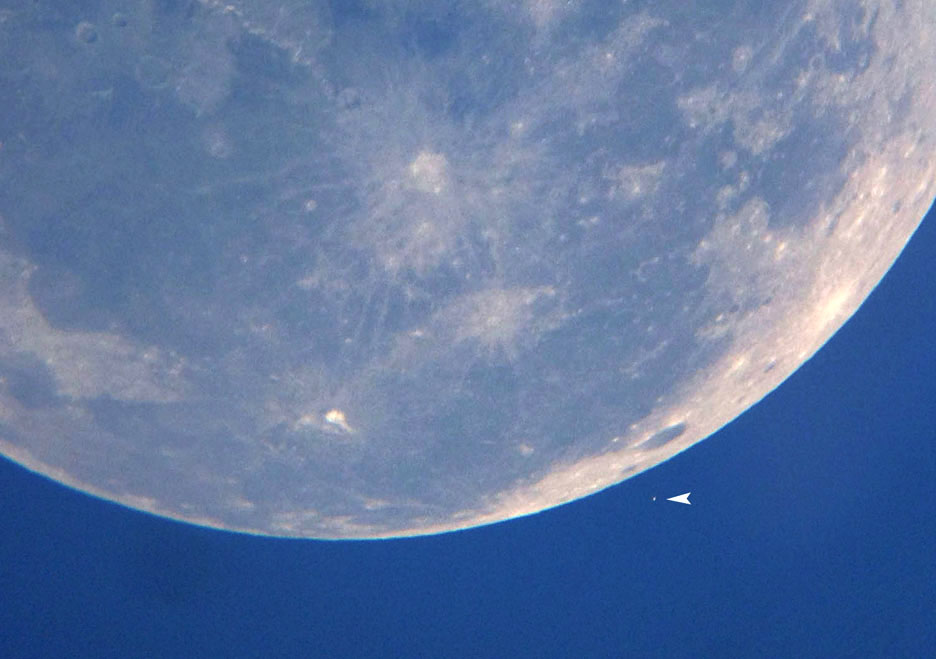Forty-nine consecutive months. That's how many times the Moon will have covered the bright star Aldebaran when the current series of occultations — begun on January 29, 2015 — ends on September 3rd. If you haven't seen one of these stunning stellar cover-ups, Tuesday morning, July 10th, will be your last chance until the next series begins in 2033.

On July 29, 2016, the waning crescent Moon grazed Aldebaran for those positioned in just the right locations. These images were acquired 0.1 second apart; south is up.
Bob Sandy / IOTA
During its 18.6 year nodal cycle, the Moon weaves between 5.1° north and south of the ecliptic because of its inclined orbit, putting it within reach of four first magnitude stars: Spica, Antares, Aldebaran and Regulus. Of these, Aldebaran is the brightest at magnitude 0.9. Because Aldebaran lies 5.5° south of the ecliptic, the Moon should theoretically pass nearly ½° north of the star every go-round. It doesn't, though, thanks to parallax.

For many locations in the Western Great Lakes, the occultation will resemble this view from Duluth with a thin crescent low in the east during at dawn.
Stellarium
Because the Moon is relatively close to Earth, it shifts position against the background stars depending on one's location. For instance, if viewed from diametrically opposite ends of Earth, say the poles, its position varies by 1.54° or three full moon diameters. From equator to pole, it's still about ¾° or 1.5 moon diameters — plenty of reach to cloak Aldebaran.
What makes Tuesday's event even more special is that none of four bright stars will be occulted again until the next Antares series begins on August 25, 2023, five years from now! What a bummer. All the more reason to set the alarm Tuesday, rub the sleep from your eyes and watch the 11% waning crescent rise next to the bright pink star.

This map shows where the July 10th Aldebaran occultation will be visible. Cyan = occultation at moonrise/moonset; red dotted = daytime occultation; blue = twilight occultation; and white = nighttime occultation. Observers living in the Great Lakes region have the best seats. From all locations, the Moon will be low in the northeastern sky during morning twilight. Click the map for more information.
Occult V4.5.9
Now for a bit of bad news. This last accessible Aldebaran occultation — the remaining two occur across the Arctic wilderness — will only be visible for observers in the Western Great Lakes region from Ontario as far west as North Dakota, Iowa, and southern Manitoba. At the western end, the Moon rises with Aldebaran already occulted, so those places will only witness the star's reappearance, which is the best part anyway.
Since the Moon will be just 2.5 days before new, it will be low in the sky for everyone — only 3° high for Minneapolis and 7° for Mackinaw City, Mich. at reappearance — so find a location with an unobstructed eastern horizon. You'll find a list of cities and times of the star's disappearance and reappearance here. Times are Universal Time, so remember to subtract 4 hours for Eastern, 5 for Central and so on.

Even a basic mobile phone can do a decent job of recording an occultation. I took this picture with an older iPhone through a 10-inch scope on Oct. 2, 2015, shortly before the Moon occulted Aldebaran an hour after sunrise.
Bob King
The good news is that even if you aren't in the path, you can still see a close conjunction of star and Moon. In New Orleans the two will be only 20′ apart shortly after local moonrise, 1° in San Francisco and a scant 4′ apart in New York when closest at 4:20 a.m. in early morning twilight. You can easily find out exactly where to look and how close the two will be for your location by downloading an app for your iPhone or Android. I use Star Chart (free) and the recently introduced free version of Sky Safari. Just Google 'em up. Be sure to bring a camera to capture this beautiful pairing.
An occultation of a bright star is a wonderful thing to witness in binoculars or a telescope. As the Moon moves eastward in its orbit, it edges ever closer to the star. Moments before disappearance, the star hovers at the limb of the Moon for what seems like forever. Then all at once, it vanishes in a flash. Minutes later, we're treated to an equally sudden "star rise" along the Moon's darkened, earth-lit limb. An incredible sight.
Catch a Grazing Occultation
You want an even more amazing sight? Travel to the graze line, where Aldebaran will scrape along the Moon's southern limb, flashing in and out of view as it alternately disappears behind mountain peaks and reappears as they travel past. Depending on your location, you may witness several to more than a dozen flashes.
Keen-eyed skywatchers may notice that Aldebaran — unlike lots of other occulted stars — won't blink out in an instant. With a radius 43 times that of the Sun, it has a true angular size, it will take a moment for the star to disappear and reappear. David Dunham, a founder of the International Occultation Timing Association (IOTA), described Aldebaran's return to view in a 1962 occultation as "appearing like a drop of water coming out of a faucet."

This diagram shows the general graze path across the U.S. Midwest and Ontario. Click for more detailed maps.
Google / IOTA
To help plan your outing, check the latest forecast at the National Weather Service site by typing in your town's name in the local forecast box.
A delicate, Earth-lit Moon and bright orange star fused in the growing light of dawn — I think this is going to be a beautiful event. I'd love to hear about your experience, so drop by later with a comment or photo.